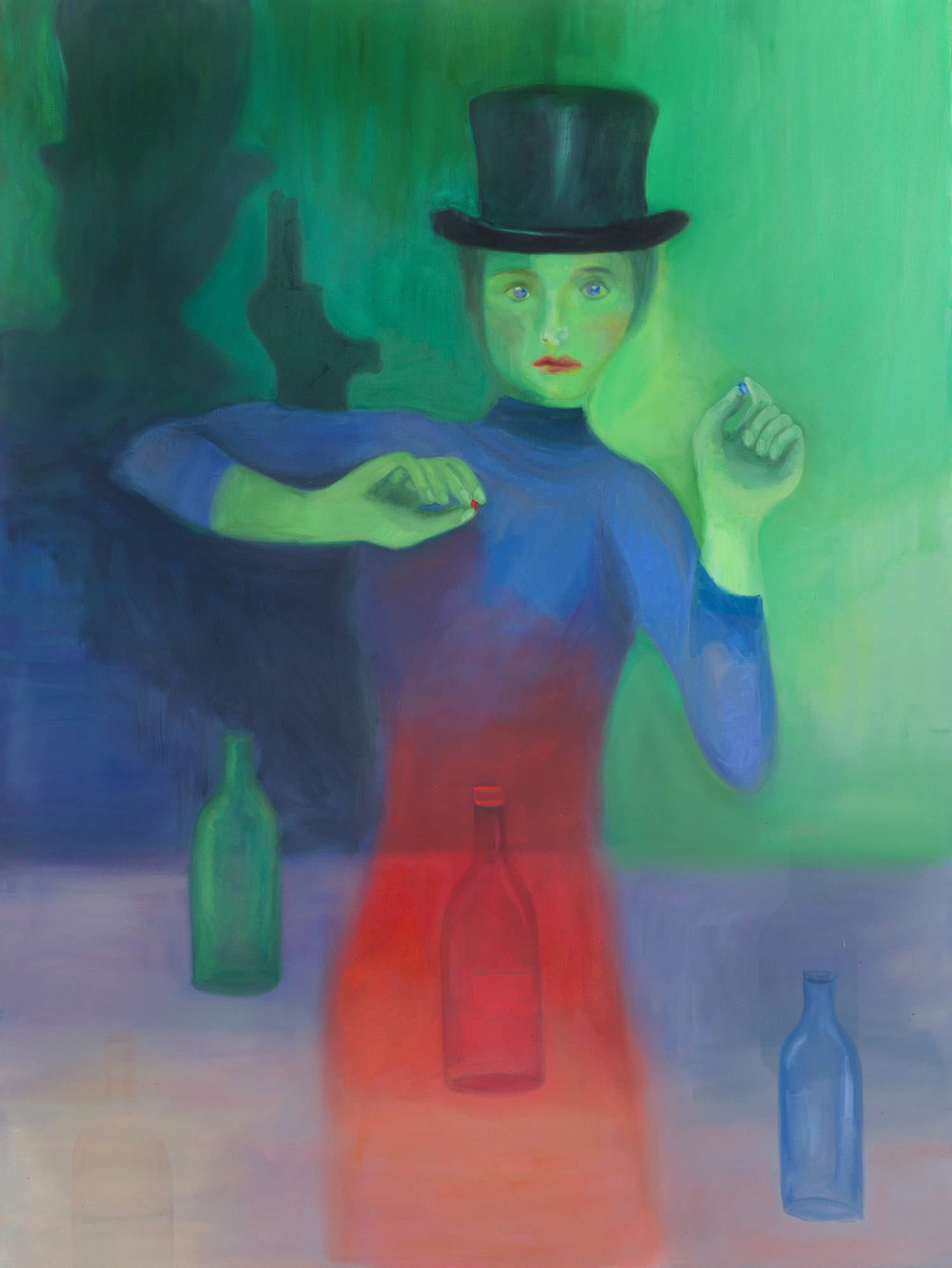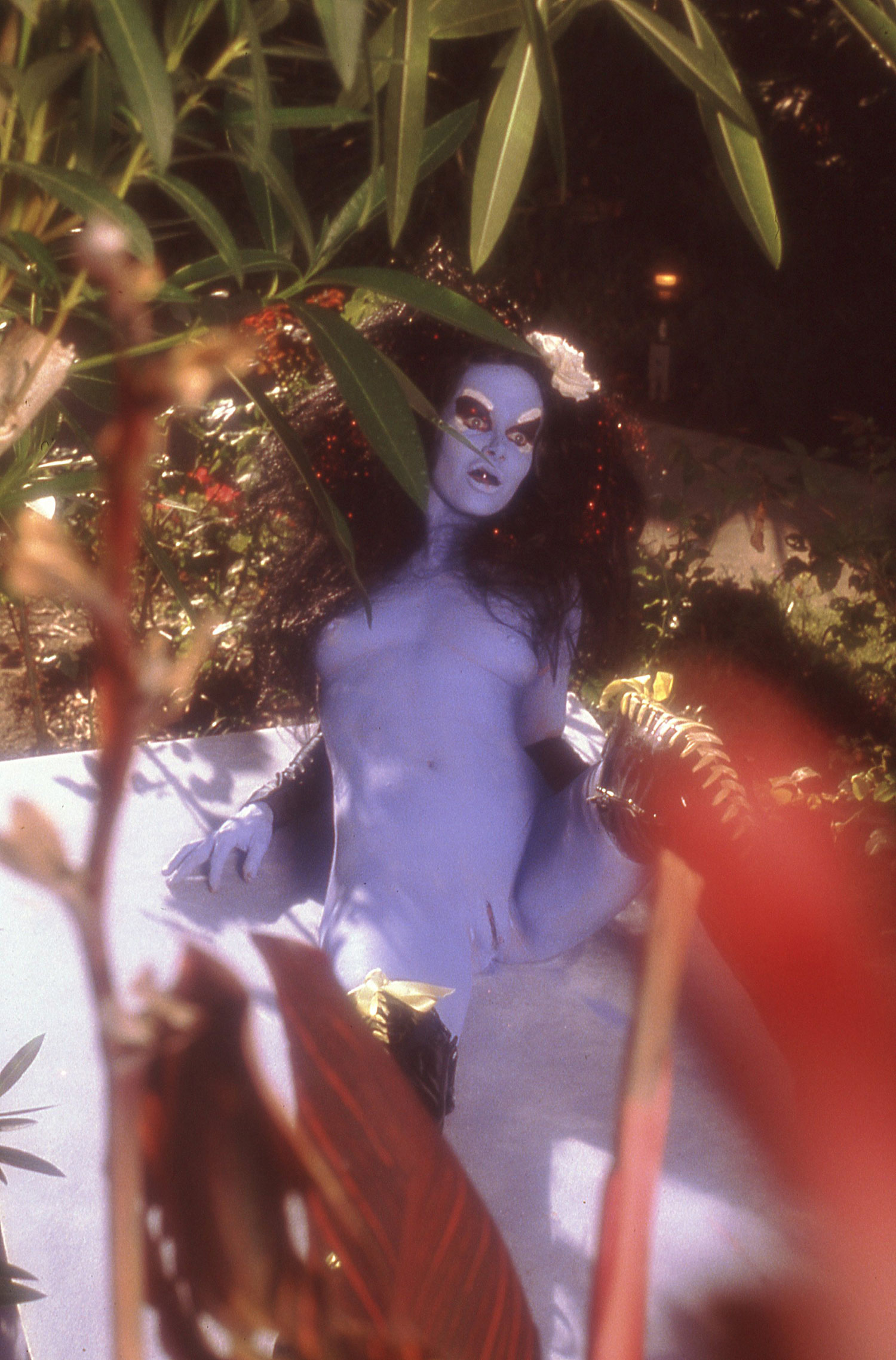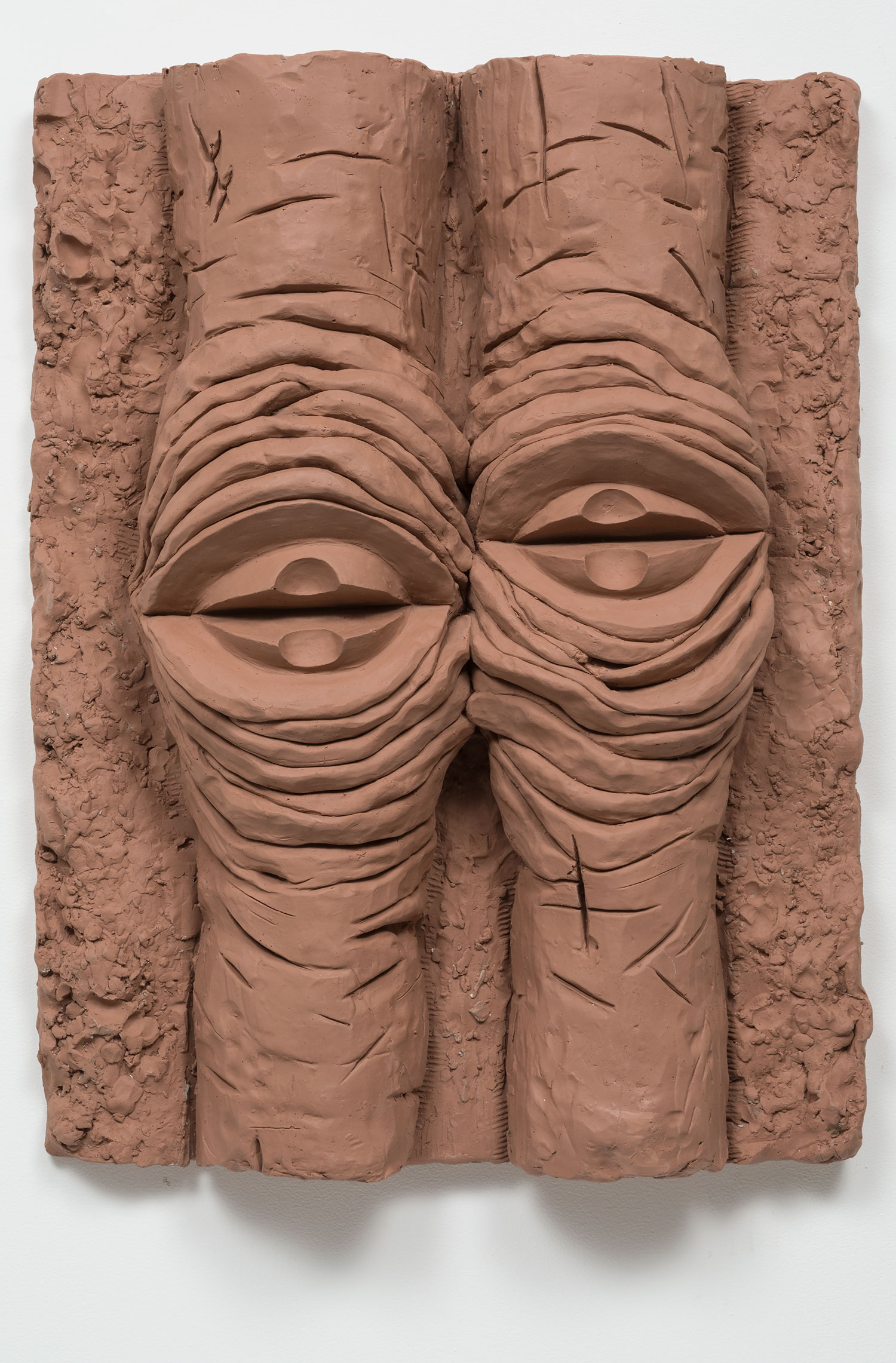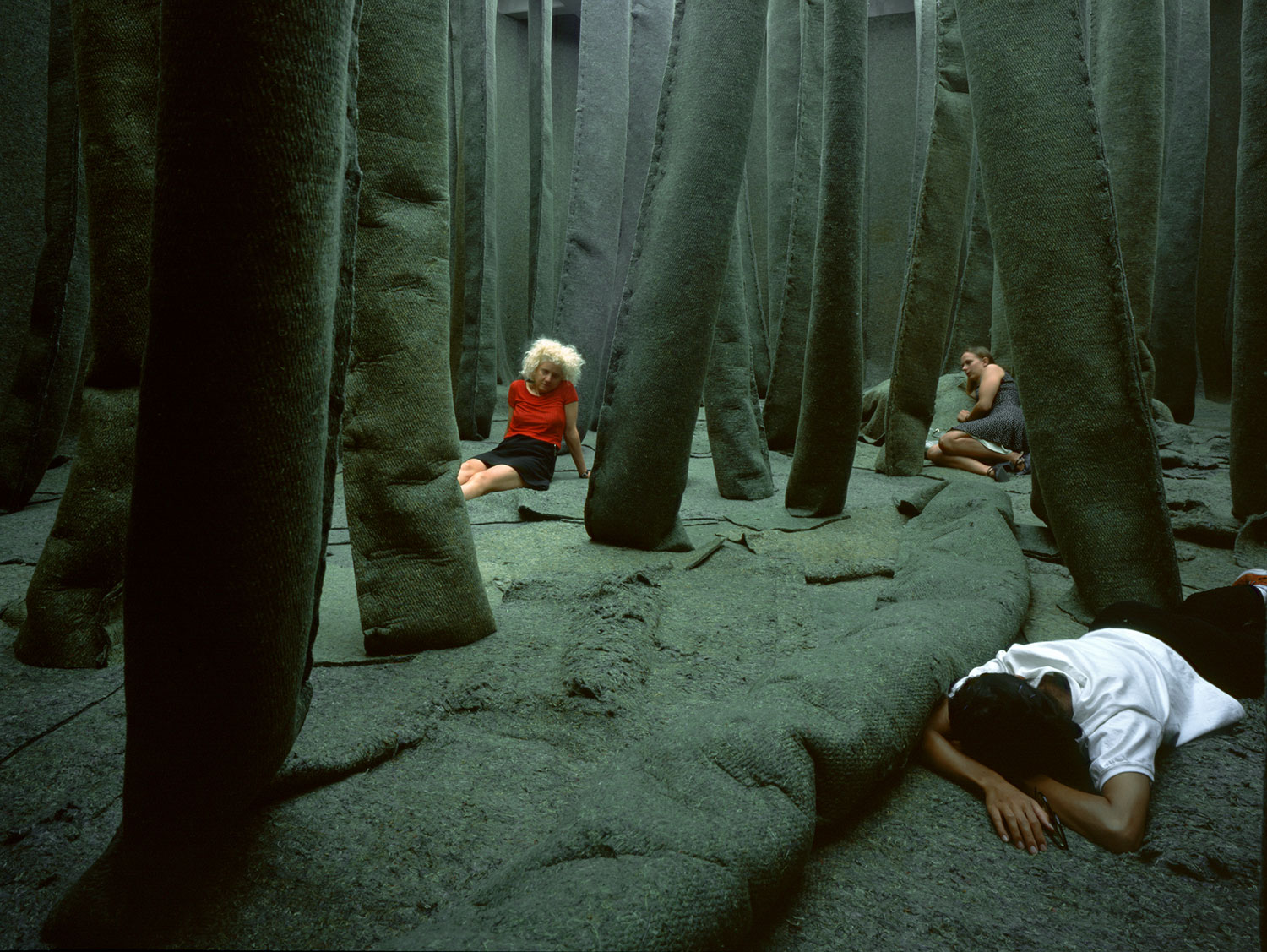
Among Maria Lai’s earliest drawings there is a compact nucleus made up of portraits of Sardinian women at work: hair tied back, gaze determined, profiles traced with just a few black lines in india ink or pencil between flat fields of color. The strokes are decisive, elastic, so much so that, when the drawings were exhibited at L’Obelisco gallery in Rome in 1957, the critics emphasized — in keeping with the inexorable cliché of the day — its “masculine” character. Lai (1919–2013) drew from an early age: before ever setting foot inside a school, at age nine, she lived with her aunt and uncle in a country house in Cardedu, where the air was healthier than in Cagliari, and where she could doodle on the walls with fireplace charcoal, getting used to using her whole arm rather than just her hand. Then she studied: at the artistic lyceum in via di Ripetta in Rome, and at the Art Academy in Venice, from 1943 to ’45, with modernist sculptor Arturo Martini, who was intent on discouraging the creative leaps of the “little girl” from a terra vergine, so obstinately determined to not be discouraged. “I entered his world like an annoyance, but in some way I made him curious. Today I know that we met in order to communicate something to each other that would go beyond that time. Over nearly three years of attending his lessons, I lived in a condition of discomfort, insecure and bewildered, and at the same time I felt like I was in the right place, more than in Rome, more than in Sardinia,” the artist recounted.2 Those drawings also marked — forcefully — Lai’s return to work after the end of the war, her return to Cagliari and her family, a long depression, and the decision to move back to the capital — where she returned to her origins and began again.
Instead of faces, she concentrated on gestures: a basket under the arm, a jug balanced on top of the head, the back bent over a washbowl, the arms folding to knead bread, the naked foot helping to spin. If these stylized gestures were archaic and already on the verge of extinction, Lai’s translation of them was contemporary: a conscious short-circuiting between past and present, as well as the ability to speak the language of both at once, as is characteristic of all of her production. Those feminine actions that she herself did not have to perform — by virtue of her class and her freedom to choose her profession — became her favorite material, as she assumed the role of a “tradition bearer,” a term coined at the UNESCO convention of 1996 to define those members of a community who become the spokespeople of its “immaterial cultural heritage,”3 recreating it and relaying it to the next generation. It is to a heritage of intangible gestures that Lai gives form, substance and continuity into the present. “The fact that my roots don’t appear clearly,” she has declared, “doesn’t mean that they’re not there or that they’re not the most defining part of my work. What does appear, namely contemporary culture, which I certainly acquired outside of Sardinia, and which allows me to dialogue with the world, is just the tip of the iceberg. […] Behind me are millennia of silence, of attempts at poetry, of festive breads, of weaving yarn.”4
Her decision to collect her culture’s “prehistoric” heritage — as she defines it — was in line with the paths pursued by close friends like the novelist Giuseppe Dessì (her neighbor in Rome) and Salvatore Cambosu, her high school teacher and later mentor, who dictated to Maria the pages of Miele Amaro (Bitter Honey), his seminal collection of Sardinian legends, stories, songs and traditions, published in 1954. The cover featured a drawing by the artist: a girl in traditional costume, with a pleated red skirt, embroidered corset and black scarf around her head. During that same period, the ethnologist Ernesto de Martino, author of Il mondo magico (The Magic World, 1948), was teaching (from 1957) at the University of Cagliari and plumbing the local traditions, while Sardinian intellectuals and politicians debated the so-called Piano di rinascita (Rebirth Plan), which would lead to the industrialization — a violent one — of the island. Following Carl Gustav Jung’s Seven Sermons to the Dead, Lai explained that art is born from fear: an affirmation that can be read in relation to her personal demons, but also to the shared fears stemming from a collective loss of identity — the loss of a “cultural fatherland,” to borrow De Martino’s phrase — threatened by the advent of modernity. It is in this sense, I think, that we can interpret Lai’s recourse to the realm of magic, which in Sardinia is a traditionally feminine heritage, handed down, together with the art of weaving, by the janas, the good faeries that live in the domus (pre-Nuragic tombs carved into the rocks, in the shape of little houses). Identifying with the figure of Maria Pietra (Maria Stone), the sorceress protagonist of the story “Cuore mio” in Miele Amaro (to which she dedicated, during the course of her career, numerous texts, drawings, hand-sewn books, performances, ceramic and bread sculptures), Lai also reestablished and renewed the myth of her own creativity.
“Women produce fabrics with images constructed in a rhythmic order, and at the same time rich with continuous mutations of form and color. These works change the history of the world. Feminine creativity contaminates the masculine. The images migrate from threads to stones, from symbols to meanings. The alphabet is born; communication across time and space; memory. Memory grows wider and becomes rhythm. With memory, the transformation of the human being matures: the poet is born, a concentrate of man, woman and deity.”5 It is to the janas, who were once bees (and whose origins Dessì narrates in La leggenda del Sardus Pater [The Legend of the Sardinian Father]6), that we owe the invention of the loom and the rigor of geometries. It was through the Telai (Looms) series that Lai went back to exhibiting, with a solo show at Galeria Schneider in Rome in 1971, at the end of another period of silent activity in her studio, far from everything. In order to find a personal and “poor” approach to sculpture, she deconstructed painting’s most classical support — the stretched and mounted canvas — and patterned it with twines, stalks of hay, clothespins, plastic cutlery and popsicle sticks, transforming it into an imaginary, however unusable, weaving loom. It was the start of a prolific period. Shortly thereafter, Lai started the Tele cucite (Embroidered Canvases) cycle, real, large-scale, increasingly abstract collages of knotted and assembled fabrics. In parallel, she began work on two series of book-objects, both illegible: “bound” ones with oven-baked bread dough covers (starting from the late 1970s), made almost as though to render the contents edible; and embroidered ones, made by using the sewing machine needle to mimic the linear flow of writing, letting tangles of colored thread hang from them (Libro scalpo [Scalp Book], 1978). These are the works with which she participated in the Venice Biennale, in the section titled “Materializzazione del linguaggio” (Materialization of Language) curated by Mirella Bentivoglio: an all-female group show, centered on the relation between sign, identity and the codification of an individual “language” rooted in gestures and corporeality. Which for Lai intersected with another feminine legacy: the memory of her grandmother’s bedsheets, mended with long stitches that to her, as a child, looked like the lines of a text needing to be deciphered. Dating to the same period is also Autobiografia (Autobiography), a series of small pictures hung facing the wall, leaving the back of the pale wood frame exposed, sometimes painted, sometimes blank, with snarls of dark thread falling from the edges, like long rebellious hair. Lai preferred to communicate with silence rather than with words — as Emanuela De Cecco notes in her book Da vicino, vicinissimo…7 — but she rediscovered a public voice and role in the moment that she immersed herself fully in the fabric of her own community.
When the municipality of Ulassai, her native town in Ogliastra, asked Lai to create a monument to the fallen, the artist refused the commission — as though hearing again the echo of Martini, who defined sculpture a “dead language,” funereal — but came back with a proposal for a monument (immaterial, free, joyous) to the living: an action that would bind together the whole town and its inhabitants. Thus Legarsi alla montagna (Tying Oneself to the Mountain, 1981) was born, following a long “relational” preparation that involved all of the local families. Lai’s best-known work, it is immortalized in a series of black-and-white photographs by Piero Berengo Gardin (later colored by the artist) and in a film by Tonino Casula, in which the contrast between the women’s traditional clothing and black shawls and the bright blue of the “modern” fabric marks the encounter between two eras. A few large pieces of donated denim were cut into strips of ribbon and tied together into a miles-long streamer that was made to go from house to house, joining each residence to the next, and explicating the relations between neighbors: a simple knot among strangers, a bow decorated with pintau breads (sculpted magisterially and gifted on special occasions) for friends and family. Having circled around the village, the streamer was taken by three climbers to the top of the mountain that stands above Ulassai, to much applause. It was a great party and also a social sculpture, which Lai modeled on a local fairytale about a girl who manages to escape a landslide thanks to the apparition of a blue ribbon. A contemporary rite for conquering fear of being devastated, wiped out, cancelled.
Legends, fairytales and stories — the underlayer of the collective imaginary — emerge from the many books that Lai worked on in subsequent years, using fabric, unprimed canvas, denim, transparent film (in the original versions, from which she then derived her printed artists’ books, published by the Cagliari-based house Arte Duchamp). But she also made an effort to reconstruct a physical space of storytelling and conversation: using the funds allocated for the never built monument, Lai refurbished Ulassai’s old wash house, an everyday meeting place for women, involving her sculptor friend Costantino Nivola in the on-site realization. In time, she created a dozen or so permanent site-specific projects that turned Ulassai into an open-air museum, and in 2006 opened the Stazione d’Arte, to which she donated a substantial collection of works. She also intervened in other Sardinian areas: for Reperto (Find, 1982), in Villasimius, she involved the schoolchildren, inviting them to play with words and time, transforming modern scrap objects, buried in sand, into future archeological finds, enclosed in Plexiglas display cases. The following year, she organized a performance in Orotelli that wove through the streets, transforming them into beehives, before arriving at the house in Cambosu. She engaged with theater by collaborating with the company Fueddu e Gestu and participating in youth theater projects all over Italy. Education and play, understood as horizontal and free spaces of experimentation and individual growth, unregulated by the norms of pre-established lexicons, assumed a growing importance in the last years of her life. And while the official art world began to pay her increasing attention (in 2008 she was included in “Italics,” curated by Francesco Bonami, at Palazzo Grassi in Venice and the Museum of Contemporary Art in Chicago), she was busy inventing games, boards, nursery rhymes and workshops, in which “the multiplied child encounters the many selves of her growth entrusted to play, to fairytales, to works of art.”8 A living language, kneaded and leavened, shared.




